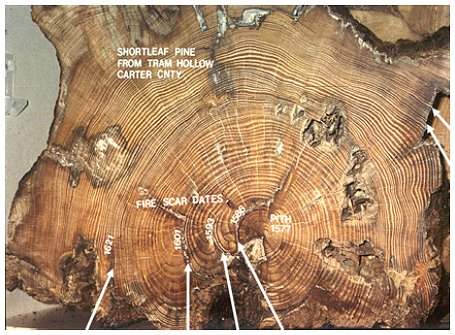AgEBB-MU CAFNR Extension
Green Horizons
Volume 20, Number 2
May 2016
Forest Science
What Can Tree Rings Tell Us?
By RICH GUYETTE | MU Department of Forestry
When I was a young artist drawing trees, I ended up on a steep limestone bluff looking for some twisted forms of red cedar to draw. Distorted wood was everywhere along the ledge. I took some curious pieces home, sawed them and examined their rings. Wow, there were hundreds of them! At first it seemed unbelievable that these trees could be growing so slow and still be alive. I hardly could believe it was possible. My interest got me into the Wood Science Department at the University of Missouri and into Dendrochronology. This brought me to studying tree rings, the centuries-long perspective trees can give us compared to our own decades-long, short human view of the world around us.
What is Dendrochronology? What can we do with the growth rings of trees? How can we date a cabin or fire scar in the woods by using tree rings? The growth of woody plants leaves a record in their annual rings that allows us to determine their age and what has affected their very existence. Like a history book, each ring is a page of what happened at that place, in that year. Trees can't move around and they only care about water and light, but foresters learn to read their rings like it is a book made for them. The language of the tree ring is read through a forester's knowledge of tree physiology, wood anatomy, and the tree's response to the climate. Indeed, the common climate within a region leaves them with similar patterns in their rings like they are all playing the same symphony!
Dendrochronology or tree-ring dating uses these common patterns in tree growth to date wood of an unknown age, whether in an old house, a forest or from a supply boat that sank in the Missouri River in the 1800's on its voyage from St. Louis to the Western Front. Patterns in tree-rings are created by annual weather conditions, the environment and forest dynamics. Regional climate causes similar growth patterns in the early wood and latewood of an annual ring-an annual ring lays down wood in the spring and summer that can be differentiated. However, this can only happen where there are seasonal annual variations in precipitation and temperature.
 |
A cross section of a shortleaf pine showing annual rings and fire scars dating back to the year 1586. Photo credit: Rich Guyette |
The scientific method of analyzing tree ring patterns is called Dendrochronology. It is recognized and used around the world and you can go to court with it. There are many fields of tree-ring science. Tree-ring techniques are used in forestry, ecology, soil and atmospheric chemistry, archaeology, geology and forensics.
One of the oldest and most extensively studied areas of Dendrochronology is Dendroclimatology which uses tree rings to study the history of past climates. Trees can give us a much longer look into past climates by our using their growth as an indicator of growing season conditions. Books, many journal publications and websites (International Tree Ring Data Bank (ITRDB), NOAA) have been developed on this subject. The ITRDB has thousands of tree-ring chronologies available that can be downloaded. The Missouri Tree Ring Laboratory (MTRL), located at the University of Missouri, has contributed many tree-ring chronologies of shortleaf pine and oak species to ITRDB. Climate and fire occurrence (fire scars) are very important subjects that have been studied in detail by the Missouri Tree Ring Laboratory. How tree species respond to variation in annual climate, from cork oak in Spain to white oak and sugar maple in Missouri and the eastern US is well documented. However, in the plant world, bur oak tends to be the master recorder of ecosystem growing season climates—its growth has even been found to be significantly correlated with hay crop yields. A thousand-year bur oak chronology from more than 200 overlapping tree-ring series found buried in North Missouri streams, tells a tale of long-term drought variability at several cycles in Missouri. Past droughts in Missouri and the Midwest from 1229-1248, 1368-1384, and 1849-1880 were more severe than anything we have seen in the last 100 years. In contrast, our recent annual precipitation is increasing and becoming more variable (61 inches in 2015, St. Louis instrumental data). This variability will result in conditions that influence tree growth and the tree's annual rings will record it, just as they did in those years of severe drought. Moreover, there will always be another young man who becomes fascinated with the unusual growth pattern of some tree species and will become inspired to study Dendrochronology!
